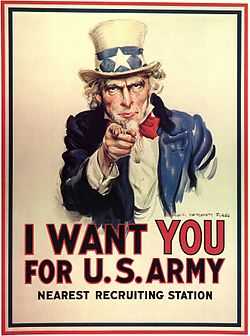Slogans of the United States Army

Slogans of the United States Army changed only rarely in the 20th century, but have been replaced more frequently in the 2000s.
2006 to present
"Army Strong" is the recruiting slogan that is used currently by the United States Army. The composer of the music used in the Army Strong television commercials is Mark Isham.[3]
2001 to 2006
"Army of One" was a relatively short-lived recruiting slogan. It replaced the popular "Be All You Can Be" and was replaced in 2006 by the new slogan "Army Strong".[4] The reason for the replacement, states Frank Luntz, is that the slogan "Army of One" is contrary to the idea of teamwork.[5] It is unknown whether this slogan was taken directly from the poster for the 1976 Clint Eastwood film The Outlaw Josey Wales, which had "An Army of One" under a drawing of the Josey Wales character. The "One" in the slogan was an acronym, standing for Officers, Non-Commissioned, and Enlisted, the three types of soldiers in the U.S. Army.
1980 to 2001
Be All (That) You Can Be was the recruiting slogan of the United States Army for over twenty years.[6] This popular slogan was created by Mark Lee Krangle at Queens College with Earl Carter in 1970 and Earl Carter used it eleven years later, at the advertising firm N. W. Ayer & Son. Earl was awarded the Outstanding Civilian Service Award for his efforts.[7] In his autobiography Soul of It All, Michael Bolton claims to have sung the jingle in the early 1980s.[8]
In his 2004 book The Men Who Stare at Goats, journalist Jon Ronson states repeatedly that "Be All (That) You Can Be" was coined by Col. Frank Burns and Lt. Col. Jim Channon sometime around 1980. The discrepancy with other accounts has not been resolved.
1971 to 1980
"Today's Army Wants to Join You" was a recruiting slogan from the 1971 Volunteer Army (Project VOLAR) campaign, which was introduced as the country prepared to transition to an all-volunteer military. When N. W. Ayer & Son, who were engaged by the US Army, believed they felt the army said "Today's Army is changing; we want to meet you half way", the firm came up with that slogan. General William Westmoreland asked "Do we have to ask it that way?" but agreed to the campaign. The slogan was replaced by "Join the People Who've Joined the Army" in 1973, which later evolved into "This is the Army."[9]
Slogan was written in 1971 by Ted Regan Jr., Executive Vice President and Executive Creative Director of N.W. Ayer, the Army's ad agency. Regan also wrote the follow up slogan, "Join the people who've joined the Army."
Circa 1950s–1971
"Look Sharp, Be Sharp, Go Army!"was a recruiting slogan in the 1950s and 1960s. The Big Picture, public announcements on broadcast television, and highway roadway signs advertised the slogan during a time of a national draft of young men 18 to 34 years of age. The advantage of volunteering for service as opposed to being drafted was the option to choose which career field you wanted to serve in along with the first unit and/or location of assignment.
World War I
"I Want YOU for US Army" featured on a poster of Uncle Sam painted by James Montgomery Flagg.
See also
References
- ↑ "The Most Famous Poster". American Treasures of the Library of Congress.
- ↑ "Who Created Uncle Sam?". Life's Little Mysteries. Live Science. Archived from the original on 3 December 2008. Retrieved 16 February 2012.
- ↑ The making of "Army Strong"
- ↑ Tyson, Anne Scott (22 November 2006). "Army Debuts New Slogan in Recruiting Commercials". The Washington Post. Retrieved 2012-06-12.
- ↑ Luntz, Frank. Words That Work. p. 119. ISBN 9781401385750.
Why did the U.S. Army jettison "be all that you can be," surely one of the most widely known taglines in the world, for the rather odd and uninspiring "An army of one"? Especially when an "army," by definition, is more than one person. While it is understandable for an organization like the military to want to individualize and personalize what it does, that's just not a believable or credible selling point.
- ↑ The Themeline That Changed The U.S. Army
- ↑ Earl Carter Awards.com
- ↑ Bickel, Britt (February 20, 2013). "Ten Tidbits From Michael Bolton’s Autobiography ‘Soul Of It All’". 94.7 The Wave (news.radio.com). Retrieved September 7, 2013.
- ↑ pp.141–142 Griffith, Robert K. & Wyndham, John U.S Army's Transition to the All Volunteer Force 1868–1974 1997 DIANE Publishing